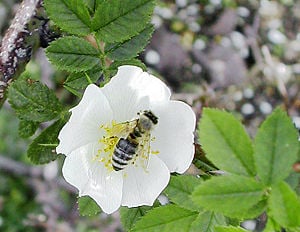Neoptera
| Neopterans | ||||||||||||
|---|---|---|---|---|---|---|---|---|---|---|---|---|
 Honeybee (order Hymenoptera)
| ||||||||||||
| Scientific classification | ||||||||||||
| ||||||||||||
|
Superorder Exopterygota
Superorder Endopterygota
For fossil groups and possible future splits, see text. |
Neoptera is a classification group that includes almost all the winged insects, specifically those that can flex their wings over their abdomens. This is in contrast with the more basal orders of winged insects (the "Paleoptera" assemblage), which are unable to flex their wings in this way.
ITIS lumps all neopteran orders together in this infraclass without subdivision; other authorities recognize several superorders within it. Almost universally accepted are the Exopterygota - hemimetabolous neopterans, in which the wings are already visible before the adult stage and no pupa or chrysalis stage occurs -, and the Endopterygota, the holometabolous insects in which the wings develop inside the body during the larval stage and only become external appendages during the pupa or chrysalis stage.
As of recently, there are several attempts to resolve the neopteran diversity further. While this appears to be less controversial than in the (apparently paraphyletic) "Palaeoptera", there are nonetheless lots of unresolved questions. For example, the hymenopterans, traditionally considered highly advanced due to their intricate social systems, seem to be far more basal among the Endopterygota, as suggested by their relatively plesiomorphic anatomy and molecular data. The exact position of the proposed Dictyoptera is also uncertain, namely whether they are better considered Exopterygota or basal neopterans.
Detailed classification
Here is a list of living and fossil neopteran orders, and the proposed superorders:
Superorder Exopterygota[verification needed]
- Caloneurodea (fossil)
- Titanoptera (fossil)
- Protorthoptera (fossil)
- Plecoptera (stoneflies)
- Embioptera (webspinners)
- Zoraptera (angel insects)
- Dermaptera (earwigs)
- Orthoptera (grasshoppers, etc)
Proposed superorder Dictyoptera
- Phasmatodea (stick insects - tentatively placed here)
- Grylloblattodea (ice-crawlers - tentatively placed here)
- Mantophasmatodea (gladiators - tentatively placed here)
- Blattodea (cockroaches)
- Isoptera (termites)
- Mantodea (mantids)
Proposed superorder Paraneoptera
Superorder Endopterygota
- Hymenoptera (ants, bees, etc.)
- Coleoptera (beetles)
- Strepsiptera (twisted-winged parasites)
- Raphidioptera (snakeflies)
- Megaloptera (alderflies, etc.)
- Neuroptera (net-veined insects)
Proposed superorder Mecopteroidea/Antliophora
- Mecoptera (scorpionflies, etc.)
- Siphonaptera (fleas and snow fleas)
- Diptera (true flies)
- Protodiptera (fossil)
Proposed superorder Amphiesmenoptera
Incertae sedis
- Glosselytrodea (fossil)
- Miomoptera (fossil)
Credits
New World Encyclopedia writers and editors rewrote and completed the Wikipedia article in accordance with New World Encyclopedia standards. This article abides by terms of the Creative Commons CC-by-sa 3.0 License (CC-by-sa), which may be used and disseminated with proper attribution. Credit is due under the terms of this license that can reference both the New World Encyclopedia contributors and the selfless volunteer contributors of the Wikimedia Foundation. To cite this article click here for a list of acceptable citing formats.The history of earlier contributions by wikipedians is accessible to researchers here:
The history of this article since it was imported to New World Encyclopedia:
Note: Some restrictions may apply to use of individual images which are separately licensed.